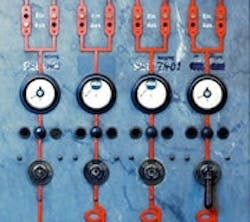Panel Meters Simplify Design
Machine and robot builder OEMs can use panel meters to cost-effectively perform three main functions. The first and most common is operator interface. The second is closed-loop control as a local backup to a main automation system. The third is stand-alone control and monitoring of an entire machine or robot, often viable for simple applications.
As an operator interface, a panel meter will beat any LCD-based HMI in terms of cost and simplicity. "Panel meters limit the technology of a machine or, in plain words, dummy down the automation system," says Jeff Thornton, Red Lion Controls' (www.redlion.net) product manager. "PLCs and HMIs have advantages, but they require a trained or experienced person to make changes, perform troubleshooting and provide support. This increases overall lifecycle costs and potential downtime."
For machines controlled by a programmable relay or a low-end PLC, a panel meter often can be the best operator interface alternative. Modern meters can communicate with controllers via digital networks such as Modbus, making the two-way data transfers necessary for operator interface viable.
[pullquote]"Our Provu meters feature dual displays, multiple indicating LEDs and front panel function keys—all user-programmable and with three-tier password protection," says Scott Ewen, engineering manager at Precision Digital (www.predig.com). "The users can configure the meter through the front panel, or by using free PC-based software."
In addition to operator interface capability, modern meters can perform real-time control. "Our high-end meters have up to eight programmable relays and up to 16 I/O," Ewen adds. These relays and I/O can be programmed much like a programmable relay or a PLC, providing a component that combines operator interface and control in one simple and low-cost package.
Ewen explains how a digital panel meter can be used to provide backup local control and operator interface for a PLC-based automation system. In this application, a conveyor motor safety-control circuit uses a meter to monitor motor-winding temperature, and a second meter to monitor motor current. Conveyor speed is controlled by the PLC, varying by recipe.
The temperature meter controls a variable-speed motor blower, used to cool the conveyor motor, via a 4-20 mA output signal. It also has a temperature warning alarm and a high-limit alarm. The warning alarm sends a digital output to the PLC, and an alarm relay output illuminates a local yellow beacon light. The high-limit alarm controls a relay that removes power to the conveyor motor via a power relay coil (PRC), and it also illuminates a local red beacon light.
The second meter receives its input signal from a current transmitter. The lower display is user-configured to display the word "Amps." The current monitor meter also is used as a locked rotor alarm, controlling the same PRC as the first meter. Digital filter settings on the input signal eliminate false alarms from start-up and noise.
This example is for a backup local control and operator interface application, but it's easy to see how this type of functionality could be applied when using a panel meter as the main and only controller and operator interface for a simple machine.
Using a panel meter as the main controller saves money up front and possibly down the road. "Machine builders need to consider support cost versus the capability of PLCs when comparing them to panel meters," Thornton says. "Even with extended capabilities, in the end they're still just panel meters and are easy to support."
OEMs might be reluctant to rely on a panel meter for real-time control, but Otto Fest, president and founder of Otek (www.otekcorp.com), says others have paved the way. "Industries in critical environments, such as nuclear and petrochemical, have grown to trust panel meters in many applications, even to the point of letting a panel meter control parts of the process on a stand-alone basis," he says. "This makes sense as long as the instrument has been tested and certified to meet certain applicable standards such as Class 1E for nuclear."


